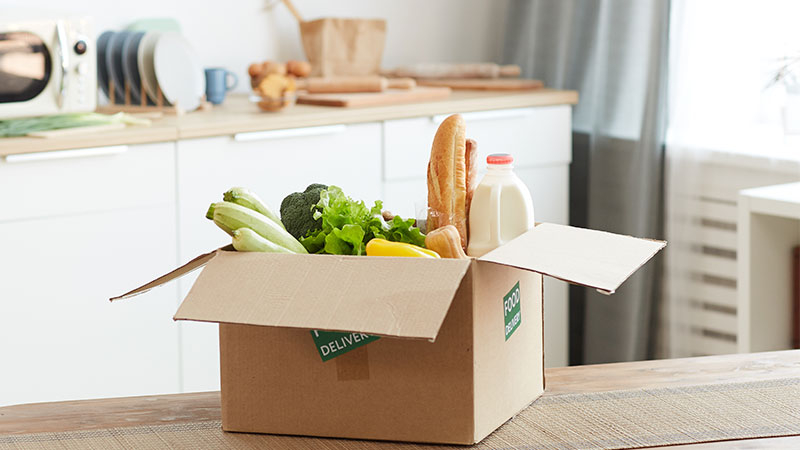- High potential attracts investors and entrepreneurs alike
- Experts predict a wave of consolidation and changing business models
- Automation as a key to profitability
(Marchtrenk, 30 August 2022) The number of businesses offering online grocery orders delivered quickly (quick commerce) has risen rapidly over the last year. Yet only a few are making a profit. Experts like scholars Dr. Matthias Schu and Dr. Michael Schedlbauer (Vice President Business Development Grocery) foresee a wave of consolidation and a change in business models coming. As they see it, automation will be a crucial lever for profitability and long-term success in online grocery retail.
In the grocery industry, the business model "quick commerce" is based mainly on the example set by Gopuff, which was founded in Philadelphia in 2013. The fundamental idea is much older than that, though, dating back to 1998. Many other startups around the globe have since adopted the strategy, including Instacart, Shipt, Getir, and Gorillas, a German start-up that in 2020 used the slogan “Faster than you” to advertise its bicycle courier delivery service. Many of these businesses promise delivery times under an hour, with some as short as ten minutes of order receipt.
Quick Commerce
The recent spike in demand for quick commerce has been fueled by the coronavirus pandemic. Personal health concerns and quarantine periods introduced many people to online grocery and food retail (e-food).
Experts divide the e-food segment into several subsegments, but the boundaries between these are getting fuzzier: purely online grocers (e.g. Thrive Market or FreshDirect), omnichannel retailers (e.g. Walmart, Kroger, or Amazon Fresh), restaurant delivery (e.g. DoorDash), those who deliver meal kits (e.g. HelloFresh) and other specialists or niche players (e.g. Imperfect Foods, Farmbox Direct, or GrubMarket).

Mega trend in retail
Since the e-food segment has achieved high double-digit growth rates over the past few years, venture capitalists and investors are already treating it as a new mega trend. Around the world, more and more companies and start-ups want a piece of the pie with most new players simply copy the existing business models. However, as industry insider Matthias Schu notes, "The copycats are going to have it rough, because even in cities with over 200,000 inhabitants there is only room for two providers." Schu, an e-food expert, teaches at the Lucerne University of Applied Sciences and is the author of "Das E-Food Buch" ("The E-Food Book") and the "Quick Commerce Report."

Characteristics
For his report, Schu compiled a market potential estimation for German quick commerce for the year 2030. The result: there is a total potential of €33.6 billion euros spread across 40 cities of over 200,000 inhabitants - and that's the conservative estimate. Countless entrepreneurs see great potential and low entry barriers, and therefore build start-ups whose services often share these characteristics:
- Delivery times of ten to fifteen minutes, no more than one hour
- Delivery by bicycle or two-wheeled motorized vehicle
- Delivery radius of less than two miles from a warehouse
- Hyperlocal fulfilment from small warehouses or stores
- Broad but shallow assortment focused on convenience
- Offering of between 700 and 3,500 items
- Mix of branded items with good margins and their own brands
Stand-alone and platform approaches
In his report, Schu identified the parameters for profitability. Many players are pumping their investors' money into marketing campaigns and expansion into urban areas, but are currently operating in the red. According to Schu, there are two main basic models: on the one hand, the so-called stand-alone approach, in which the companies control their entire value-added chain. They operate warehouses or dark stores and have their own employees pick orders and their own delivery personnel deliver the goods. Examples for this model include Amazon Fresh, Walmart, or Getir.

On the other hand, there is the platform approach, where the quick commerce company acts as "orchestrator". They carry out the core tasks within the value-added chain and coordinate all other processes with partners. Instacart and Shipt are examples of this model. The grocery retailers where the orders are picked are responsible for storage and assortment; this is known as the "asset light" approach. As Schu explains, the appeal of this approach is the idea that a combination of different offers and retailers can be brought together under one roof and the product risk remains with the partnering retailers.
The advantages are greater selection for customers, better distribution of fixed costs among the platform suppliers, and exploitation of other income streams, like revenue sharing. If the listing of partnering retailers includes bakeries or flower shops, they can attract customers who are looking for local goods and appreciate the advantages of quick delivery. Generally speaking, Michael Schedlbauer, expert in the area of grocery retail at TGW, considers the platform model more advantageous than the stand-alone solution: "Because, as a rule, it offers the possibility of larger shopping carts due to the wider range of items and other revenue streams. However, it does require partnerships in order to be successful."
Picking efficiency as a critical variable
No matter which model they use, all quick commerce players want to be profitable, and preferably sooner rather than later. But that is easier said than done. This industry is characterized by narrow margins and high personnel costs. One challenge is the high portion of costs spent on picking and delivery. According to a study conducted by Capgemini in 2018, the "last mile" accounts for 46 percent of the total costs. Schu and Schedlbauer say that there are five variables that companies could manipulate to still have a chance at profitability:
- Shopping cart total: One option is to introduce a minimum order amount. But it shouldn't be too high, according to Schu, because that would drive away customers. Optimizing the product range by primarily offering high-margin products is also a good idea.
- Delivery fee: In quick commerce, current delivery fees generally do not cover the full delivery costs. According to Schedlbauer, companies are currently able to carry the additional delivery costs, but he expects this won’t last, resulting in fees varying considerably in the future. One solution is dynamic pricing, similar to the airline industry’s pricing model
- Advertisement subsidies: This is common in retail but has not yet been entirely embraced by quick commerce. Industry expert Schu considers it a good idea to recommend products via apps or websites in order to generate revenues.
- Increased efficiency during the last mile: The classic logistical solution of striving for the highest number of delivery stops per hour is not feasible with under-15-minute delivery times. Such promises require expensive 1:1 order delivery rides. Schu believes that delivery times will soon be extended, allowing for destination point consolidation and implementation of route-planning software. He does not consider autonomous deliveries by robots to be a possibility in Europe within the next five years.The increase in competition from new quick commerce players is forcing more traditional omnichannel players to offer shorter and more flexible delivery times as well. However, a one hour delivery time is already somewhat economically challenging for these businesses because the bundling of deliveries during the last mile is becoming less and less efficient. Anyone offering extremely quick deliveries within minutes must dispatch deliveries directly from a store, and do so with corresponding higher prices.
- Increased efficiency during picking: Fundamentally, there is little potential here compared to classic retail and omnichannel operations. With such low item quantities and small warehouses, comprehensive automation is not financially attractive in the short- or medium-term. Nevertheless, retail expert Schedlbauer is of the opinion that fulfilment automation will be necessary in high-wage countries in order for companies to become and remain profitable in the long-term. Automation of large distribution centers or a network of micro fulfilment centers (MFC) will be the way to go because they will reduce personnel costs and support a consolidated and more efficient last mile delivery.
Wave of consolidation
Both Schu and Schedlbauer are convinced that quick commerce is a fad and that a wave of consolidation is imminent. "Right now, many businesses are hoping to be bought out by other players," says Schedlbauer. He expects that delivery times will soon be extended to 30 or 45 minutes and that such quick deliveries will be offered as a premium service. Chains like Kroger would carry out these extremely quick, premium deliveries from their stores, with all other deliveries from their warehouses. In his opinion, the large businesses who partner with delivery services have the best chance of surviving in the long-term. Such delivery services also profit from this platform model, because even if the demand for groceries wanes, they can utilize their workforce to capacity by delivering other goods such as flowers, drug store items, or pizza.





